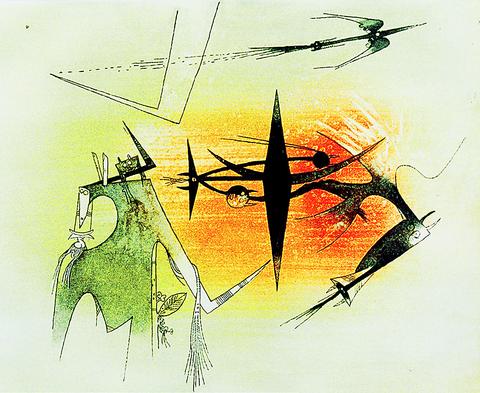Summer is usually the low season for galleries, but this time around there are some rare, legendary figures on exhibit in Taipei. Wifredo Lam (
Lam is a significant figure in the modern art history of the 20th century. He is closely related to Picasso and other surrealist artists. Alleged as the first Third World artist that went beyond the frontiers of his own cultural and religious origins, Lam paints with a hybrid style, a mixture of surrealistic figures with Cubist character.
Born to a Chinese father and African mother, Lam's mixed origins influenced his magical and mysterious style, and added richness to the surrealistic quality of his works. At the age of 12, Lam already possessed a flair for distilling figures down to their most basic characteristic features. Lam had fantasies ever since he was a child, seeing bat-like or dragon-like beasts in shafts of sunlight that leaked through his windows. The funny, unreal beasts on view at the gallery are good testimony to his childhood musings. Also evident in the prints on display is his practice of using African sculptural totems in his art, a trademark that stretched throughout his artistic career.

PHOTO: CAVES ART CENTER
Lam left Cuba for Europe in 1923. He studied in Madrid and then left for Paris in 1938. He quickly became a good friend of Picasso, who also introduced him to other prominent artists, such as Henri Matisse and Joan Miro. In reading Picasso, he said he felt empathy with his paintings because of the presence of African art and the African spirit.
In his early days, Lam used broad and thick brushstrokes to outline his images. His most representative and precious work is The Jungle, dated 1942. The pictorial world that Lam created in The Jungle showcases numerous creatures in Cubist dimensions, with a thick, greenish backdrop of trees and leaves, a rarity to his latter works that had mostly empty, cleaner backgrounds.
When Lam shifted to using thinner outlines, his work took on a greater sense of precision. The imaginative beasts in his pictures became thinner and sharper, with triangular faces, hollow eyes, and over-stretched bodies.

PHOTO: GALERIE GRAND SIECLE
Li Hsiang-ming (李

On April 26, The Lancet published a letter from two doctors at Taichung-based China Medical University Hospital (CMUH) warning that “Taiwan’s Health Care System is on the Brink of Collapse.” The authors said that “Years of policy inaction and mismanagement of resources have led to the National Health Insurance system operating under unsustainable conditions.” The pushback was immediate. Errors in the paper were quickly identified and publicized, to discredit the authors (the hospital apologized). CNA reported that CMUH said the letter described Taiwan in 2021 as having 62 nurses per 10,000 people, when the correct number was 78 nurses per 10,000

As we live longer, our risk of cognitive impairment is increasing. How can we delay the onset of symptoms? Do we have to give up every indulgence or can small changes make a difference? We asked neurologists for tips on how to keep our brains healthy for life. TAKE CARE OF YOUR HEALTH “All of the sensible things that apply to bodily health apply to brain health,” says Suzanne O’Sullivan, a consultant in neurology at the National Hospital for Neurology and Neurosurgery in London, and the author of The Age of Diagnosis. “When you’re 20, you can get away with absolute

When the South Vietnamese capital of Saigon fell to the North Vietnamese forces 50 years ago this week, it prompted a mass exodus of some 2 million people — hundreds of thousands fleeing perilously on small boats across open water to escape the communist regime. Many ultimately settled in Southern California’s Orange County in an area now known as “Little Saigon,” not far from Marine Corps Base Camp Pendleton, where the first refugees were airlifted upon reaching the US. The diaspora now also has significant populations in Virginia, Texas and Washington state, as well as in countries including France and Australia.

May 5 to May 11 What started out as friction between Taiwanese students at Taichung First High School and a Japanese head cook escalated dramatically over the first two weeks of May 1927. It began on April 30 when the cook’s wife knew that lotus starch used in that night’s dinner had rat feces in it, but failed to inform staff until the meal was already prepared. The students believed that her silence was intentional, and filed a complaint. The school’s Japanese administrators sided with the cook’s family, dismissing the students as troublemakers and clamping down on their freedoms — with